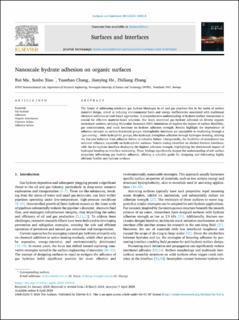| dc.contributor.author | Ma, Rui | |
| dc.contributor.author | Xiao, Senbo | |
| dc.contributor.author | Chang, Yuanhao | |
| dc.contributor.author | He, Jianying | |
| dc.contributor.author | Zhang, Zhiliang | |
| dc.date.accessioned | 2024-04-12T10:20:06Z | |
| dc.date.available | 2024-04-12T10:20:06Z | |
| dc.date.created | 2024-04-11T16:36:40Z | |
| dc.date.issued | 2024 | |
| dc.identifier.issn | 2468-0230 | |
| dc.identifier.uri | https://hdl.handle.net/11250/3126261 | |
| dc.description.abstract | The future of addressing persistent gas hydrate blockages in oil and gas pipelines lies in the realm of surface material design, aimed at reducing environmental harm and energy inefficiencies associated with traditional chemical additives or heat-based approaches. A comprehensive understanding of hydrate-surface interactions is crucial for effective material-based solutions. Our study examined gas hydrate adhesion on diverse organic monolayer surfaces, utilizing Molecular Dynamics (MD) simulations to explore the impact of surface flexibility, gas concentration, and crack locations on hydrate adhesion strength. Results highlight the dependence of adhesion strength on surface functional groups, with hydrophobic interfaces susceptible to weakening through a “gas coating”. Hydrophilic groups, like hydroxyl, strengthen adhesion through hydrogen bonding, altering the fracture behavior from adhesive failure to cohesive failure. Unexpectedly, the flexibility of monolayers has minimal influence, especially on hydrophobic surfaces. Tensile testing identified six distinct fracture interfaces, with the ice-hydrate interface displaying the highest adhesion strength, highlighting the detrimental impact of hydrogen bonding on interface weakening. These findings significantly deepen our understanding of soft surface properties influencing gas hydrate adhesion, offering a valuable guide for designing and fabricating highly efficient flexible anti-hydrate surfaces. | en_US |
| dc.description.abstract | Nanoscale Hydrate Adhesion on Organic Surfaces | en_US |
| dc.language.iso | eng | en_US |
| dc.publisher | Elsevier | en_US |
| dc.rights | Navngivelse 4.0 Internasjonal | * |
| dc.rights.uri | http://creativecommons.org/licenses/by/4.0/deed.no | * |
| dc.title | Nanoscale Hydrate Adhesion on Organic Surfaces | en_US |
| dc.title.alternative | Nanoscale Hydrate Adhesion on Organic Surfaces | en_US |
| dc.type | Journal article | en_US |
| dc.type | Peer reviewed | en_US |
| dc.description.version | publishedVersion | en_US |
| dc.source.volume | 48 | en_US |
| dc.source.journal | Surfaces and Interfaces | en_US |
| dc.identifier.doi | 10.1016/j.surfin.2024.104314 | |
| dc.identifier.cristin | 2261157 | |
| dc.relation.project | Sigma2: nn8084k | en_US |
| dc.relation.project | Sigma2: nn9110k | en_US |
| dc.relation.project | Norges forskningsråd: 302348 | en_US |
| dc.relation.project | Sigma2: nn9391k | en_US |
| cristin.ispublished | true | |
| cristin.fulltext | postprint | |
| cristin.qualitycode | 1 | |

